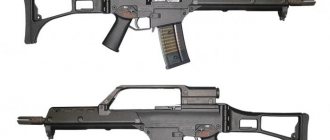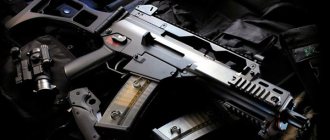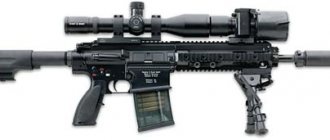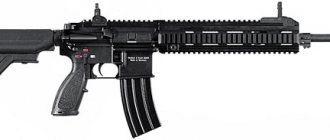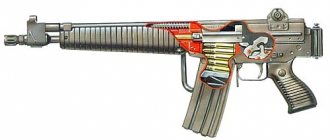Heckler & Koch HK G11 assault rifle
The G11 Heckler rifle serves as an individual small arms weapon for a Bundeswehr soldier and is designed to defeat enemy personnel. The G11 Heckler rifle is the development of West German designers, which replaced the G3 rifle. In the mid-60s of the 20th century, the concept of armament of motorized infantry units of NATO armies began to change, incl. and units of the Bundeswehr. According to NATO analysts, the main strike “self-defense forces,” as the arms race businessmen liked to call themselves, are armed with an assault rifle that is not light enough to meet the requirements of modern times.
Development of new standard weapons
G11 - this is the name given to the new assault rifle; it was developed by the German company Heckler and Koch in the late 1960s. The German government approved this project and ordered the production of the required type of weapons as soon as possible. During the design and survey work, the designers settled on a light, small-caliber and compact rifle in the “bullup” version with high accuracy. In this case, the clip is structurally attached above the barrel, the cartridges in it are defined in diameter to the barrel bore. The effectiveness of hitting a target was achieved by hitting it with several shots, so the designers settled on the option of using a 43 mm caseless cartridge in the new weapon (later they chose a 47 mm caliber). The updated rifle could fire single shots and fire in automatic mode, both in long and short bursts of 3 shots. According to the developed concept, the Heckler-Koch company was entrusted with the creation of the new G11, and the Dynamite-Nobel company was responsible for creating a new shot without a shell.
.
Design features of G11
. The automatic circuit of the weapon operates due to the kinetic energy of the powder gases released after the shot and the short stroke of the barrel. The initial placement of cartridges in the clip above the barrel with bullets down. The G11 rifle is equipped with a special rotating breech chamber, where before the start of fire the cartridge is fed vertically downwards. After this, the breech is turned at a right angle, and when the cartridge is aligned with the line of the barrel, a shot is fired, while the cartridge is not fed directly into the barrel. Because the cartridge is without a shell (the capsule burns out when fired), then the operation of the automation is simple: there is no need for the mechanism to throw out the spent cartridge case. After the shot is fired, the breech chamber turns back to receive the next ammunition. If it misfires, the defective cartridge is thrown down under the influence of the feed force of the next ammunition. The mechanism is cocked using the rotary handle located on the left. The handle does not move when shooting.
The barrel part, the trigger (except for the safety flag and trigger), the rotating breech with mechanisms and the clip are assembled on one base, which moves translationally inside the body of the weapon. When firing single shots or automatic non-fixed shooting, the mechanism completes the entire shot cycle, and the recoil becomes less. When firing automatically in fixed bursts, after every third shot the movable system comes to the rearmost position, while the recoil force acts after the end of the shooting, thereby achieving greater accuracy of fire (by analogy with the domestic AN-94 “Abakan” assault rifle). The first modifications of the G11 were equipped with a fixed, single-magnification optical sight, which is also used when carrying the rifle.
Ammunition
For standard use, shellless cartridges with dimensions of 4.73x33 mm, manufactured by Dynamit Nobel AG, have been developed. The prototype ammunition for the Heckler & Koch G11 had a square-shaped powder charge, coated with a moisture-proof varnish, a primer with an igniter in the bottom and a bullet recessed in the powder charge. Next, they created a modified version of the ammunition for the Heckler & Koch G11, where the bullet and powder charge are completely encapsulated along with the primer - the igniter in the bottom part and the lid at the top of the capsule.
Modifications
The Bundeswehr is armed with two types of such weapons: - Heckler & Koch G11K2 rifle - an updated version of the G11. The body has been shortened, a bayonet mount and a clip for 45 shots have been developed. The sight is a removable weapon handle; instead it is possible to install standardized sighting devices adopted by NATO troops. - Heckler Heckler&Koch LMG11 - light machine gun based on the Heckler&Koch G11
Caliber: 4.7×33 mm, cartridge without casing Automatic: gas vented, with rotating breech Length: 0.750 m Barrel length: 0.540 m Weight: 3.6 kg without ammunition Clip: 50 (45) shots
Ammunition
For standard use, cartridges without a shell with dimensions of 4.73x33 mm
, manufactured by Dynamit Nobel AG. The prototype ammunition for the Heckler & Koch G11 had a square-shaped powder charge, coated with a moisture-proof varnish, a primer with an igniter in the bottom and a bullet recessed in the powder charge.
Next, they created a modified version of the ammunition for the Heckler & Koch G11, where the bullet and powder charge are completely encapsulated along with the primer - the igniter in the bottom part and the lid at the top of the capsule.
patron_bez_obolochki
patron_bez_obolochki_1
Design
The appearance of the 2022 BMW 7 Series has been significantly updated - the exterior is discreet and very conservative, and corresponds to the style of luxury Bavarian sedans with strict lines running along the body.
The drag coefficient (cX x A) has been reduced by 15 percent to:
- 0.24 x 2.41 (740i, 730d);
- 0.24 x 2.42 (740Li, 730Ld);
- 0.25 x 2.41 (730d xDrive);
- 0.25 x 2.42 (730Ld xDrive);
- 0.27 x 2.41 (750i xDrive);
- 0.27 x 2.42 (750Li xDrive, M760Li xDrive);
The main changes in the design are the front and rear of the car.
At the front, the new BMW 7 Series is equipped with narrow adaptive headlights (which can optionally be laser - first appeared on production cars) harmoniously connected with the proprietary radiator grille (with built-in active air flaps with the ability to adjust the flow of incoming air in five positions, depending on the cooling needs of the engine ) and a protruding bumper with powerful air intakes.
The rear part has pleased with new lights with LED optics and a large chrome trim, aesthetically merging with the new image of luxury.
As for the side, here the new 7 Series sedan received rear-view mirrors of a new shape and a stylish metal trim with a small air vent on the front wings, which further emphasizes the power of the new BMW and removes air flow, which also has an effect on reducing drag.
In general, compared to its predecessor, the F0x series, the G1x has become much sportier in appearance and has grown slightly in length.
External comparison of BMW F02 and G12
| (dimensions in mm) | G11/G12 | F01/F02 |
| Length | 5098/5238 | 5079/5219 |
| Width | 1902 | 1902 |
| Height | 1467/1479 | 1471/1481 |
| Wheelbase | 3210 | 3070/3210 |
| Front track | 1618 | 1611 |
| Rear track | 1646 | 1650 |
| Clearance | 135 | 152 |
| Trunk volume, liters | 515 | 501 |
The BMW 7 Series G11/G12 is available in nine metallic and two non-metallic paint finishes.
Depending on the modification, the car is standardly equipped with 17- or 18-inch alloy wheels. Light alloy wheels ranging in size from 17 to 21 inches are available as an option.
Learn more about the differences between the G11 and G12 series antifreezes
What antifreeze should you buy when choosing between G11 and G12? It is better to buy a product for the cooling system that is recommended by the manufacturer. However, there is one basic rule: if there are any brass parts in the motor (this can be attributed to almost all old cars), then you need antifreeze for the motor cooling system of the inorganic type G11.
- The use of G12 with new technology in such vehicles is contraindicated.
- It is commonly believed that different types of antifreeze are colored in different shades. Of course, after purchasing, you should pay attention to the shade - this will make it possible to distinguish antifreeze by color.
- Many drivers believe that Series 12 automotive antifreeze dries slowly due to its consistency. This is partly true and this is another difference from the 11th generation.
- Antifreeze 11 in its consistency is a little similar to sunflower oil in its density.
Important to consider: look at the label on the container when purchasing the mixture. If you purchased 11th or 12th generation antifreeze concentrate, then before adding it, you should dilute the concentrate with distilled water in the amount indicated on the container.
In order to keep the cooling system mechanism in working condition longer, you should not mix antifreeze and antifreeze. However, you can independently check the mixtures for their compatibility if you really can’t wait to fill your engine with the cooling mixture and mix them in a small volume in a basin.
G12 series antifreeze - what color does it have?
Typically this antifreeze is red. Keep in mind that the additives added to G12 antifreeze can effectively resist the appearance of a film. This technology is designated Long Life and its main advantage is that the cooling mixture functions to cool the engine for a much longer time.
But replacing G11 antifreeze with a newer G12 antifreeze is only possible if the engine does not contain non-ferrous metals, since the carboxylate composition of G12 antifreeze almost immediately breaks the entire protection of the engine.
Let's start with the shade
What does the difference in shades mean between the antifreeze version G11 and the newer G12? The generally accepted classification of cooling mixtures in the automotive world was created at one time by Volkswagen in Europe. At that time, it was proposed to produce cooling mixtures of the so-called inorganic properties with advanced characteristics (G11) - blue and green antifreezes with numerous additives. Also organic antifreeze. origin (designated as G12) - usually produced in pink and red colors.
Important: this established shade system is used quite often, but still is not an established standard. In other words, there is practically nothing obliging companies to engage in such release of products to the market and somehow adhere to the technology.
Often manufacturing companies try to paint engine mixtures in a proprietary or specific shade. That is why, when choosing a new antifreeze for your engine, you should not pay attention to the shade, but simply consider the accepted product labeling.
The basis of each composition for cooling a motor of any type is a chemical base called ethylene glycol, or the base may be called propylene glycol. These substances can have a huge coefficient of so-called temperature increase, as well as a weak freezing point of the mixture. Among other things, the mixture for cooling the engine usually includes plain water and several additives for better service of the mixture for the benefit of the engine.
It is worth considering that manufacturing companies add additives to many types of G11 that can suppress the corrosion process during operation of the mixture. It also contains fluorescent additives and anti-foam additives with anti-cavitation additives.
Modifications
The Bundeswehr has two types of such weapons:
— Heckler rifle Heckler&Koch G11K2
— updated version of G11. The body has been shortened, a bayonet mount and a clip for 45 rounds have been developed. The sight is a removable weapon handle; instead it is possible to install standardized sighting devices adopted by NATO troops;
— Heckler Heckler&Koch LMG11 light machine gun
- based on the Heckler&Koch G11 assault rifle. It is distinguished by the placement of a 300-round magazine in the butt of the machine gun (a corresponding influx of the power supply system has appeared on the left side of the body) and a folding front handle.
vintovka_G11_1
Transmission
The 7 Series is equipped with an 8-speed Steptronic transmission.
| 740i/Li | 750i/Li, M760i xDrive | 730d/Ld | |
| I | 5,000 | 5,000 | 5,000 |
| II | 3,200 | 3,200 | 3,200 |
| III | 2,143 | 2,143 | 2,143 |
| IV | 1,720 | 1,720 | 1,720 |
| V | 1,314 | 1,313 | 1,313 |
| VI | 1,000 | 1,000 | 1,000 |
| VII | 0,822 | 0,823 | 0,823 |
| VIII | 0,640 | 0,640 | 0,640 |
| R | 3,456 | 3,478 | 3,478 |
| main gear | 3,077 | 2,813 | 2,563 |
Engines
At the start of series production, the new BMW 7 Series is available with 4-, 6-, 8-cylinder petrol and diesel power units, of which three engine variants are completely new and one upgraded. One model with a hybrid powertrain is also available.
The base version of the BMW 730i/Li is equipped with a 258-horsepower four-cylinder B48 engine.
The range of sedans with 6-cylinder petrol units consists of the BMW 740i G11 and 740Li G12 with a 326-horsepower B58B30M0 engine. The all-wheel drive BMW 750i xDrive G11 and 750Li xDrive G12 are equipped with a V-shaped modernized 450-horsepower “eight” N63B44O2 Biturbo.
Diesel versions are equipped only with a 6-cylinder engine. The BMW 730d/xDrive G11 and 730Ld/xDrive G12 are equipped with a 265-horsepower B57D30O0. On the BMW 740d xDrive G11 and 740Ld xDrive G12 there is a 320-horsepower version of the same B57 engine.
The most powerful top-end diesel version is equipped with a B57 engine with four turbines, which at the time of the model’s release is the most powerful 6-cylinder power unit in the world.
The range of hybrid versions at the time of presentation consists of the BMW 740e G11 and an extended version of the BMW 740Le G12 with a 258-horsepower four-cylinder B48B20 power plant paired with an electric motor.
In February 2022, the top-end version M760Li with a 600-horsepower N74B66U1 power unit joined the lineup.
From 2022, a diesel version of the BMW 725d G11 and an extended wheelbase version of the BMW 725Ld G12 are available for the European, Turkish, Japanese and Korean markets. These modifications are equipped with a B47 engine.
| 730i/Li | 740i/Li | 750i/Li | M760Li | 730d/Ld | 740Ld | 750d/Ld | 740e | |
| Volume, cm³ | 1998 | 2998 | 4395 | 6592 | 2993 | 2993 | 2993 | 1997 |
| Power, hp/rpm | 258/5000 | 326/5500 | 450/5500 | 610/5500 | 265/4000 | 320/4400 | 400/4400 | 258+95 |
| Torque, Nm/rpm | 400/1550 | 450/1380 | 650/1800 | 800/1550 | 620/2000 | 680/1750 | 760/2000 | 400+250 |
| Compression ratio, :1 | 10,2 | 11,0 | 10,5 | 10,0 | 16,5 | 16,5 | 16,0 | — |
| Maximum speed, km/h | 250 | 250 | 250 | 250 | 250 | 250 | 250 | 240* |
| Acceleration from 0 to 100 km/h, sec. | 6,2 | 5,5 | 4,4 | 3,7 | 5,8 | 5,2 | 4,6 | 5,5 |
| Fuel consumption per 100 km, liters | 6,0 | 6,6 | 8,1 | 12,8 | 4,5 | 4,9 | 5,9 | 2,1 |
* — maximum speed on electric power is limited to 120 km/h
